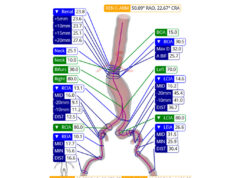
Inspection of aortic lumen, wall and thrombus volume changes throughout the cardiac cycle enables novel classification of abdominal aortic aneurysms (AAAs) into four types “representing the complex wall-lumen-thrombus interaction,” a new study delivered during the 2025 Critical Issues America (CIA) in Aortic Endografting meeting in Miami (Feb. 7–8) showed.
The finding is among the latest results brought by Randy Moore, MD, a vascular surgeon at the University of Calgary in Alberta, Canada, who is one of the driving forces behind an emerging technology aimed at providing an algorithm-driven route to precision care—RAW (Regional Areas of Weakness) Maps (ViTAA Medical Solutions).
The current investigation of the technology from Moore and colleagues involves patients who were selected from two studies—one including patients who underwent surgical repair of AAA from 2016–2023, and those in a retrospective study of AAA growth at 12 months based on surveillance imaging, also from 2016–2023. Multiphase computed tomography (CT) of 14 patients were obtained from Peter Lougheed Hospital in Calgary, with the geometries of the aortic wall and lumen segmented from the images, Moore explained.
Writing in the Journal of Vascular Surgery-Cases, Innovations and Techniques (JVS-CIT), where the findings were recently published, Moore and colleagues—led by first author Alice Guest, PhD, from the University of Calgary’s Department of Biomedical Engineering—laid out how “the relative changes of wall, lumen and thrombus volumes throughout the cardiac cycle classified AAAs into the four types.” These are described as type I (aneurysms with a minimal wall movement, negative lumen expansion and positive intraluminal thrombus expansion); type II (aneurysms whose lumen undergoes small expansion, while the expansion is accommodated by the intraluminal thrombus and wall); type III (a transition type characterized by lumen, wall and thrombus expansions); and type IV (characterized by lumen expansion matching or exceeding wall expansion, while the thrombus exhibits very small or negative deformation).
This phenotypic classification of AAA based on complex interactions has not been previously described, Moore and colleagues reveal. The AAA classification system can improve the assessment of clinical risk for aneurysms, they report, with type I “associated with a stiff aneurysm wall that resists thrombus deformation and may be related to the risk of dissection.” Types II and III are “transition types,” and type IV “is associated with the formation of permeable channels and thrombus cracks which may indicate possible risk of rupture.”
At CIA 2025, Moore described how ViTAA analysis of the aortic wall during 4D scanning identifies wall weakness (RAW Maps), concluding, “4D analysis of wall-lumen-thrombus kinematics allows for phenotypical classification of the aortic wall.”












